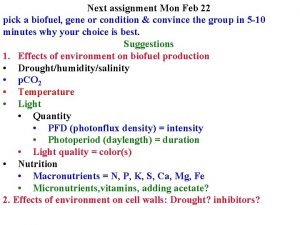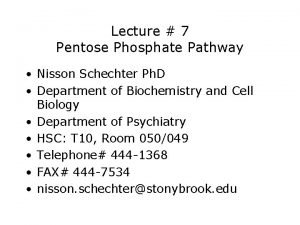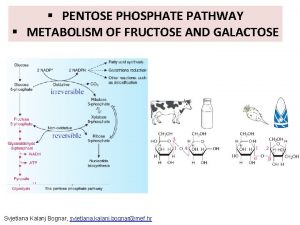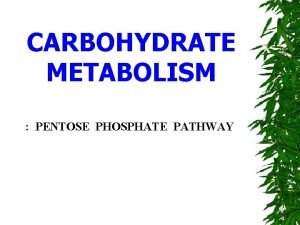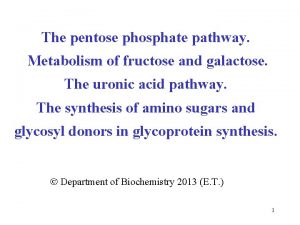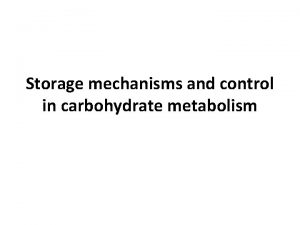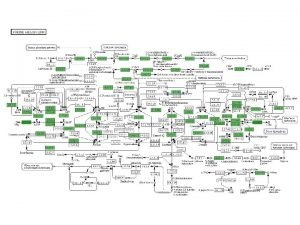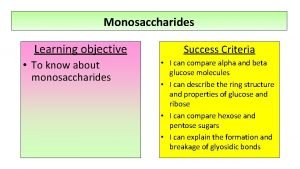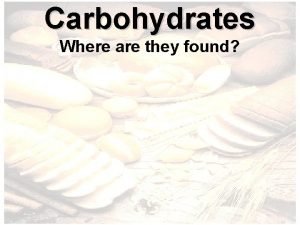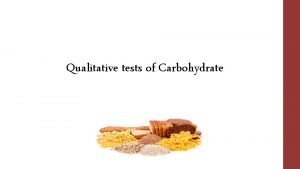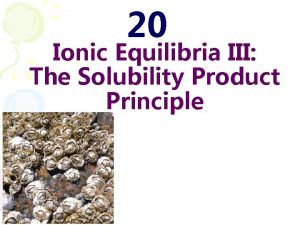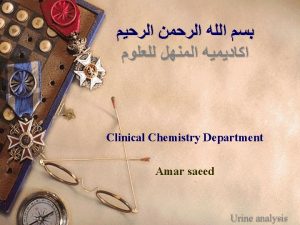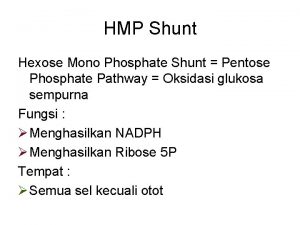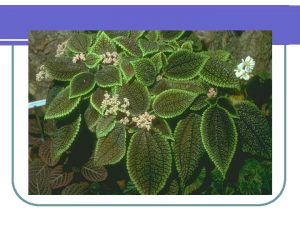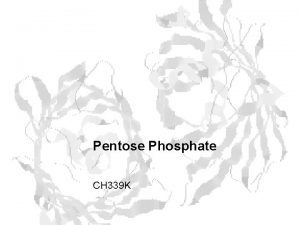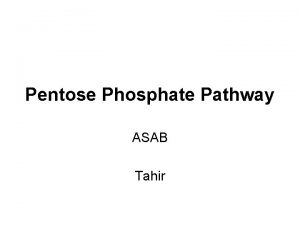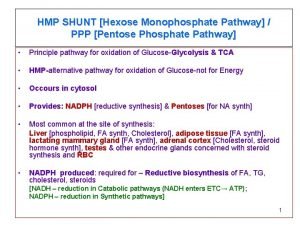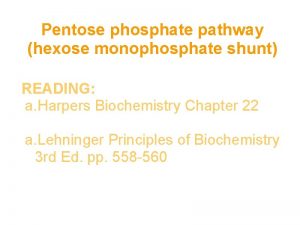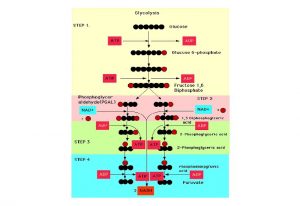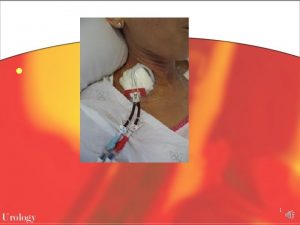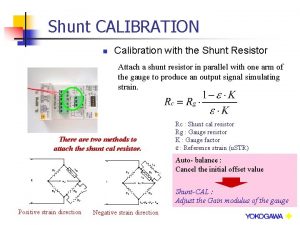PENTOSE PHOSPHATE SHUNT 1 Pentose phosphate shunt is













- Slides: 13

PENTOSE PHOSPHATE SHUNT

1. Pentose phosphate shunt is an anabolic pathway that occurs in the cytoplasm 2. Generates 3 , 4, 5, 6 and 7 carbon sugars and NADPH 3. Functions: a. To generate NADPH (the main hydrogen donor), for reductive biosynthesis reactions (fatty acid and steroids) in the cytoplasm. Enzymes involved in this pathway is found mainly in adipose tissue, liver, mammary glands and adrenal cortex b. To provide the cell with ribose-5 -phosphate (R 5 P) for the synthesis of the nucleotides and nucleic acids (DNA and RNA), some coenzymes and ATP. c. To form intermediates for glycolysis and gluconeogenesis 4. Has both an oxidative and non-oxidative pathway

1. Oxidation steps utilises glucose 6 -P and occurs at the start of the pathway and generates NADPH 2. 1 mole of NADPH each for every mole of glucose-6 -phosphate (G 6 P) that enters the PPP web. indstate. edu/thcme/mwking/pentose-phospha. . .

1. Non oxidative reactions function to generate ribose 5 -P 2. PPP also convert dietary 5 -C sugars into 6 (fructose-6 -phosphate) and 3 (glyceraldehyde-3 -phosphate) carbon sugars which can be utilised by the glycolytic pathway. 3. Transketolase: transfer 2 -C grps; require thiamine pyrophosphate as coenzyme 4. Transaldolase: transfer 3 -carbon grps 5. Summary: a. R 5 P production b. 3 moles of 5 -C sugar are converted, via the enzymes of the PPS, back into 2 moles of 6 -C sugars and 1 mole of 3 -C sugar c. 6 -C sugars can be recycled into the pathway in the form of G 6 P generating more NADPH d. 3 -C sugar generated is glyceraldehyde-3 phsphate and passed to glycolysis and oxidized to pyruvate e. Pyruvate can be utilized by the gluconeogenic enzymes to generate more 6 carbon sugars (fructose-6 -phosphate or glucose-6 phosphate). web. indstate. edu/thcme/mwking/pentose-phospha. . .

www. steve. gb. com/science/molecules. html

www. nd. edu/~aseriann/pentoalt. html

Regulation of Pentose Phosphate Shunt Metabolism of glucose 6 -phosphate depends on cellular requirements 1. Cellular requirement for ribose 5 -phosphate exceeds requirement for NADPH a. glucose 6 -P will not be oxidised via the oxidative phase of the PPS because this will generate NADPH as well. b. Glucose 6 -P will be oxidised via glycolysis to form fructose 6 -P and glyceraldehyde 3 -P which will combine to form ribose 5 -P via the non oxidative phase Reaction 5 Glucose 6 -P 4 Fructose 6 -P + 2 Glyceraldehyde 3 -P 6 ribose 5 -P Pathway Notes Glycolysis Utilises 5 ATP PPS Transaldolase & Transketolase

Cellular requirement for ribose 5 -phosphate exceeds requirement for NADPH 5 Glu 6 -P 5 Fruc. 6 -P 1 Fruc. 1, 6 -b. P DHAP Gly 3 -P 2 Xyl 5 -P 2 Erit-4 -P 2 Sed 7 -P 4 Ribulose 5 -P 4 Ribose 5 -P 2 Xyl 5 -P 2 Gly 3 -P 2 Ribose 5 -P

Cellular requirement for ribose 5 -phosphate exceeds requirement for NADPH Reaction 5 Glucose 6 -P Glyceraldehyde 3 -P Pathway 4 Fructose 6 -P + 2 Glyceraldehyde 3 -P ribose 5 -P Notes Glycolysis Utilises 5 ATP 6 PPS Transaldolase & Transketolase Cellular requirement for ribose 5 -phosphate equals that of NADPH 5 Glu 6 -P Ribose 5 -P + 2 NADPH Reaction Glucose 6 -P + 2 NADP+ + H 2 O Ribose 5 -P + 2 NADPH + 2 H+ + CO 2 Pathway Notes PPS Produces 2 NADPH

Cellular requirement for NADPH exceeds requirement for ribose 5 -phosphate 6 NADPH 6 x Ribulose 5 -P 6 x 6 -fosphogluconate 6 x Glu 6 -P 6 CO 2 2 Xyl 5 -P 2 Ribose 5 -P Pentose Phosphate Shunt (Non Oxidative) 2 Gly 3 -P 2 Fruc. 6 -P Gluconeogenesis 4 x Glu 6 -P 2 Sed 7 -P 2 Xyl 5 -P 2 Erit-4 -P 2 Fruc. 6 -P 2 Gly 3 -P Glu 6 -P

Reaction Pathway 6 Glucose 6 -P + 12 NADP+ + 6 H 2 O 6 Ribulose 5 -P 6 Ribose 5 -P + 6 CO 2 12 NADPH + 12 H+ 4 Fructose 6 -P + 2 Glyceraldehyde 3 -P + H 2 O 5 Glucose 6 -P + Pi Notes PPS (Ox) PPS (Non-Ox) Gluconeogenesis Transaldolase & Transketolase

3 NADPH 3 x Glu 6 -P 3 NADPH 3 x 6 -fosphogluconate 3 x Ribulose 5 -P 3 CO 2 Ribose 5 -P Xyl 5 -P Cellular requirement for NADPH exceeds requirement for ribose 5 -phosphate but requires ATP Gly 3 -P Fruc. 6 -P Sed 7 -P Erit-4 -P Xyl 5 -P 2 ADP (-2 ATP) 2 Fruc. 1, 6 -b. P 2 DHAP Glycolysis Fruc. 6 -P Gly 3 -P 5 NADH 2 Gly 3 -P (4) 5 Pyruvate + 10 ATP

Reaction Pathway Notes 3 Glucose 6 -P + 6 NADP+ + 5 NAD+ + 8 ADP + 5 Pi 5 Pyruvate + 3 CO 2 + 5 NADH + 6 NADPH + 8 ATP + 2 H 2 O + 8 H+ PPS 7 & Glycolysis 6 NADPH. 5 NADH + 8 ATP
 Pentose phosphate shunt
Pentose phosphate shunt Oxidative pentose phosphate pathway
Oxidative pentose phosphate pathway Pentose phosphate pathway non oxidative phase
Pentose phosphate pathway non oxidative phase Pentose phosphate pathway
Pentose phosphate pathway 6 phosphogluconate structure
6 phosphogluconate structure Gluconeogenesis of amino acids
Gluconeogenesis of amino acids Amidophosphoribosyltransferase
Amidophosphoribosyltransferase Series shunt feedback amplifier
Series shunt feedback amplifier Difference between hexose and pentose
Difference between hexose and pentose Different types of saccharides
Different types of saccharides Molisch test for carbohydrates
Molisch test for carbohydrates Nucleotide nomenclature
Nucleotide nomenclature So4pb
So4pb Urine microscopy
Urine microscopy
